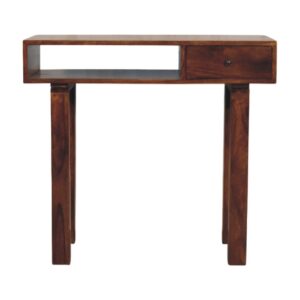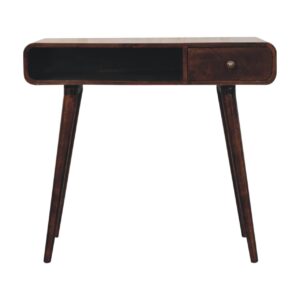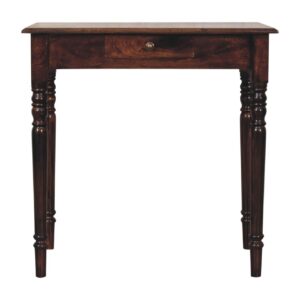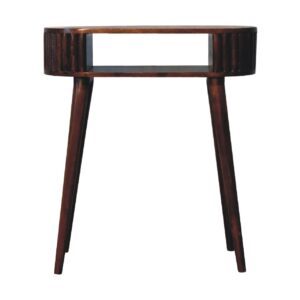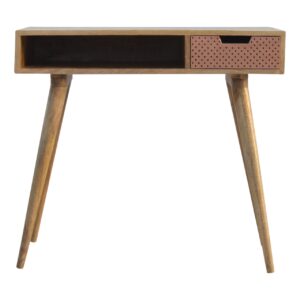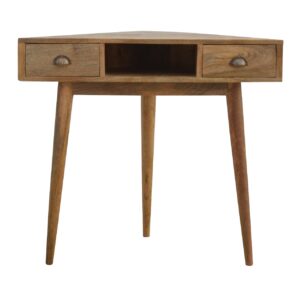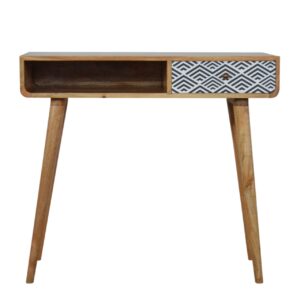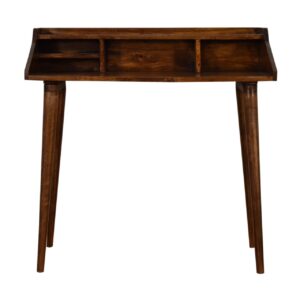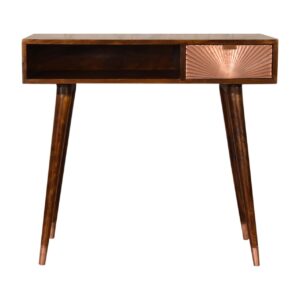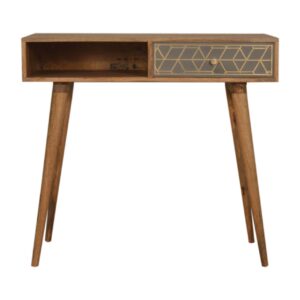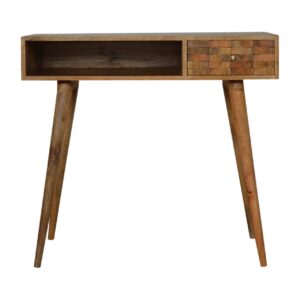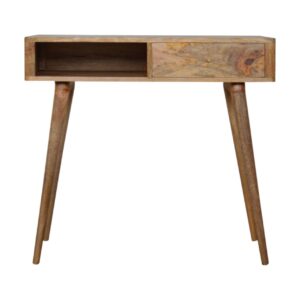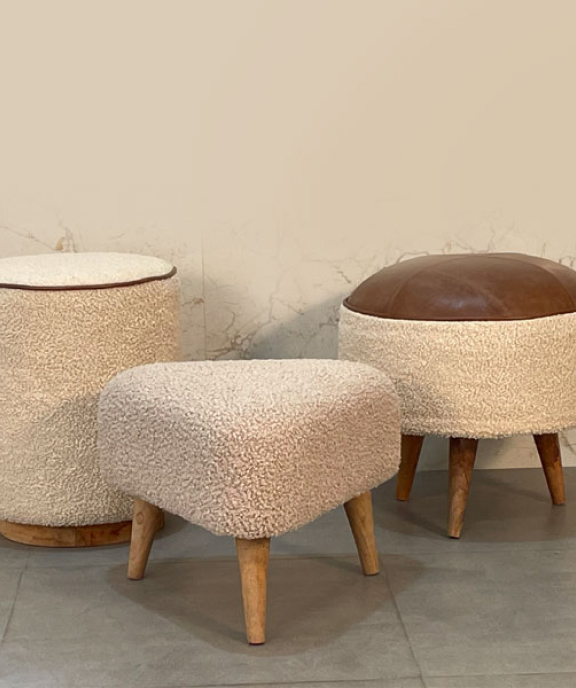In the quest for maintaining the elegance and durability of writing desks, the selection of an appropriate wood polish is paramount. This article meticulously examines the top nine wood polishes that ensure your writing desk not only gleams with a lustrous sheen but also receives comprehensive protection from daily wear and tear.
We delve into the nuances of high-quality polish characteristics, comparing natural versus synthetic ingredients and their effects on the wood’s integrity. Furthermore, we provide insights into application techniques that contribute to achieving a flawless finish.
The review encompasses a range of products suitable for various wood types and finishes, facilitating informed choices for both connoisseurs and novices in furniture care.
Join us as we explore the essentials of desk maintenance post-polishing and share best practices to ensure the longevity of your cherished piece.
Importance of Right Wood Polish
While many factors contribute to the longevity and beauty of writing desks, selecting the appropriate wood polish is crucial for preserving the wood’s integrity and enhancing its natural allure. An expertly chosen wood polish not only imparts a radiant sheen but also provides essential wood nourishment, ensuring the desk withstands the rigors of daily use and environmental factors.
The process of polish selection must be undertaken with a discerning eye, taking into account the specific type of wood, its grain, and the desired finish.
Professional custodians of fine furniture understand that wood polish goes beyond mere aesthetics. It is a protective embrace that shields the wood from dust, moisture, and light degradation. High-quality polishes penetrate the surface, replenishing the natural oils of the wood that can be depleted over time. This nourishment is vital for preventing the wood from drying out, which can lead to unsightly cracks or warping.
Thus, the judicious selection of an appropriate wood polish is a testament to one’s commitment to preserving the functional elegance of a writing desk for years to come.
High-Quality Polish Characteristics
Adept selection of a wood polish hinges on recognizing characteristics that ensure both protection and enhancement of the wood’s natural beauty. In the pursuit of a superior product, one must consider the polish viscosity, which plays a crucial role in the application process. A high-quality wood polish should have a consistency that allows for a smooth, even spread without causing drips or runs, which can mar the finish and highlight imperfections. The ideal viscosity ensures that the polish penetrates the wood fibers adequately, offering deep nourishment and a lasting sheen that accentuates the grain and coloration of the wood.
Furthermore, the formulation of the polish should be critically evaluated for its potential to cause allergic reactions. Wood polishes that are hypoallergenic and free from harsh chemicals not only provide a safer user experience but also contribute to a healthier indoor environment. Professionals in the field advocate for products that contain natural oils and waxes, which minimize adverse reactions while delivering a robust barrier against wear and environmental factors.
Natural Vs. Synthetic Ingredients
How do natural ingredients compare to synthetic ones in the formulation of wood polishes for writing desks? When selecting a wood polish, understanding the distinction between natural and synthetic ingredients is imperative for both the conservation of the writing desk and the well-being of its user.
Natural polishes often derive from plant-based oils and waxes, like beeswax or carnauba, which are renowned for their nourishing and protective qualities. Ingredient sourcing for natural polishes typically emphasizes sustainability and minimal environmental impact.
Conversely, synthetic polishes may include chemicals such as silicone or petroleum derivatives, which offer a robust barrier against moisture and wear. However, the production of synthetic ingredients can be less eco-friendly, and there may be greater allergy considerations to account for, as they can sometimes emit volatile organic compounds (VOCs) that may trigger reactions in sensitive individuals.
Professionals in the field tend to appreciate natural polishes for their gentle treatment of wood and biodegradable nature, while acknowledging that synthetic options may provide a more durable finish. It is crucial for consumers to weigh these factors, alongside their personal or commercial sustainability and health priorities, when deciding on the ideal polish for their cherished writing desks.
Enhancing Shine, Ensuring Protection
Beyond the choice between natural and synthetic ingredients, an effective wood polish should both accentuate the wood’s aesthetic appeal and provide a durable layer of protection against daily wear and environmental factors.
A professional approach to wood care dictates that surface preparation is pivotal; a meticulously cleaned and sanded surface ensures that the polish adheres evenly and performs optimally.
Polish varieties cater to different needs: some are designed to penetrate deeply, rejuvenating wood from within, while others form a hard, protective shell on the surface. High-quality polishes should offer UV resistance to prevent fading and an anti-dust formula to keep the desk looking pristine.
When applied correctly, these polishes not only enhance the natural grain and coloration of the wood but also resist watermarks and stains, prolonging the life and beauty of the writing desk.
Selecting a polish that aligns with the specific type of wood and the finish of your writing desk is essential. For instance, a beeswax-based polish might be preferred for antique desks to preserve their authenticity, while a more robust urethane-based polish may serve a modern work desk better, offering a tougher line of defense against the rigors of daily use.
Application Techniques for Perfection
Proper application is crucial to maximizing the efficacy of wood polishes, ensuring an even coat and a flawless finish on writing desks. The application process begins with understanding the polish viscosity, which dictates the method of application. High-viscosity polishes require a deliberate, controlled approach to prevent an overly thick application, which can lead to unsightly buildup. Conversely, low-viscosity polishes may be applied more liberally but necessitate careful leveling to avoid drips and runs.
Using the appropriate buffing tools is essential for achieving a professional-grade finish. Soft cloths are ideal for applying and spreading polish evenly across the wood surface. When it comes to buffing, employ a clean, lint-free cloth to work the polish into the wood grain in a circular motion. This technique helps in filling the pores and accentuating the natural beauty of the wood. For intricate carvings or hard-to-reach areas, consider using specialized brushes or cotton swabs to ensure thorough coverage.
Review: Top 9 Wood Polishes
We now turn our attention to the top nine wood polishes on the market, each carefully evaluated for its ability to bring out the best in writing desks. When considering the vast array of polish brands, discerning woodworkers and furniture enthusiasts seek products that offer a balance of protection, ease of application, and aesthetic appeal.
Firstly, Howard Feed-N-Wax stands out with its restorative properties, particularly for antique desks, and is reasonable in price.
Next, the Minwax Polycrylic Protective Finish offers a durable layer against scratches, and the polish prices reflect its premium quality.
Thirdly, Guardsman Anytime Clean & Polish delivers a streak-free shine with a modest cost, making it accessible for regular maintenance.
Additionally, Old English Furniture Polish has a longstanding reputation for deep cleaning and conditioning, while the pricing is competitive within the market.
For eco-conscious consumers, Daddy Van’s All Natural Beeswax Polish is a non-toxic choice, albeit at a higher price point reflecting its organic ingredients.
The remaining four polishes, including the likes of Method Wood for Good Polish and Pledge Lemon Enhancing Polish, vary in price and cater to a range of preferences from natural ingredients to synthetic formulations, all ensuring the longevity and beauty of writing desks.
Desk Maintenance Post-Polishing
After selecting and applying an ideal wood polish, consistent upkeep is crucial to preserve the writing desk’s sheen and protective finish. The maintenance of a polished desk involves a disciplined approach to surface cleaning, which not only enhances its appearance but also extends the life of the wood’s surface.
Routine dusting with a soft, lint-free cloth is recommended to prevent the accumulation of particulates that can scratch or dull the surface. For deeper cleaning, a damp cloth can be used, followed immediately by a dry cloth to prevent water spots or damage.
Scratch repair is another aspect of post-polishing maintenance that requires attention. Minor scratches can often be masked with a touch-up marker or wax pencil that closely matches the desk’s color. Deeper scratches may necessitate a more involved repair process, including sanding the affected area and reapplying the appropriate finish.
Furniture Care Best Practices
To ensure the longevity and aesthetic appeal of your writing desk, it is essential to adopt a comprehensive furniture care regimen. Diligent surface cleaning forms the foundation of this regimen, as it prevents the accumulation of dust and debris that can scratch or dull the wood’s finish. A soft, lint-free cloth should be used to gently wipe the surface; for more stubborn grime, a mild, wood-safe cleaner may be employed, taking care to avoid over-saturation which can cause damage to the wood.
When selecting a polish, careful consideration is paramount to not only enhance the desk’s sheen but also to protect and condition the wood. It is advisable to choose a product specifically formulated for the type of wood your desk is made from, as this ensures compatibility and prevents adverse reactions. A high-quality polish should be applied with a soft cloth, using circular motions to work it into the grain, followed by buffing to a gleaming finish.
Adherence to these furniture care best practices will contribute significantly to the preservation of your writing desk’s functional elegance, ensuring it remains a centerpiece of productivity and style for years to come.
Durability and Longevity Tips
Regular application of a suitable wood polish is one of several critical steps to significantly extend the life and maintain the resilience of your writing desk. For optimal durability, it is essential to understand the specific needs of your desk’s material and finish type.
Various finish types, such as shellac, lacquer, or oil-based finishes, require tailored care to ensure their longevity. To address the unique demands of each finish, consider seasonal treatment as part of your maintenance regimen. Wood, being a natural material, responds to environmental changes. Seasonal fluctuations in humidity and temperature can cause wood to expand and contract, potentially compromising the integrity of the desk’s surface over time.
A routine application of polish, appropriate to the season, can provide a protective barrier that mitigates these effects. Furthermore, when selecting a wood polish, seek out products that offer UV protection to prevent sun damage, which can lead to fading and weakening of the wood fibers.
Regular dusting combined with periodic polishing not only enhances the aesthetic appeal but also fortifies the desk against daily wear and tear. By diligently following these durability and longevity tips, you will ensure that your writing desk remains both functional and beautiful for years to come.
Frequently Asked Questions
Can Wood Polish Be Safely Used on Antique Writing Desks Without Damaging the Original Finish or Value?
Wood polish can be applied to antique desks cautiously. Prior antique assessment and awareness of restoration risks are essential to preserve the desk’s integrity and value without impairing the original finish.
Are There Specific Brands of Wood Polish That Are Recommended by Professional Furniture Restorers or Conservators?
Professional furniture restorers often refrain from public brand endorsements, yet specific products may be recommended based on proven restoration techniques and compatibility with the wood’s age and finish.
How Do Environmental Factors Such as Humidity and Sunlight Exposure Affect the Choice of Wood Polish for a Writing Desk?
Climate considerations such as humidity and sunlight exposure critically influence the selection of wood polish, with durability factors being paramount to protect desks from warping, fading, and moisture-related deterioration.
Can Wood Polishes Be Used on Desks With a Veneer Finish, or Do They Require a Different Type of Care?
Wood polishes are suitable for veneer finishes, with careful selection essential to maintain integrity. Opt for gentle, veneer-specific products to ensure appropriate care and preservation of the desk’s surface.
Are There Any Safety Precautions That Should Be Taken When Using Wood Polish in a Home With Pets or Small Children?
When using wood polish in environments with pets or children, it’s crucial to mitigate inhalation risks and consider potential pet allergies by ensuring adequate ventilation and choosing non-toxic, pet-friendly products.


